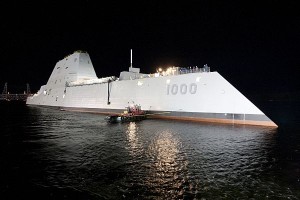 The LCS and DDG-1000 are both very different, and yet, they are also very similar–each sports controversial non-traditional hull-forms, minimal crews, no bridge wings, non-traditional hull materials, as-yet undeveloped hi-tech weapons and cost-growth. And while the LCS gets kicked around for these qualities/faults/weaknesses, the DDG-1000 always gets a pass. Every time.
The LCS and DDG-1000 are both very different, and yet, they are also very similar–each sports controversial non-traditional hull-forms, minimal crews, no bridge wings, non-traditional hull materials, as-yet undeveloped hi-tech weapons and cost-growth. And while the LCS gets kicked around for these qualities/faults/weaknesses, the DDG-1000 always gets a pass. Every time.
It’s amazing. Even with something as mundane as a shift in the usual Christening ceremony, the LCS was beat up while the DDG-1000 sailed along, unperturbed.
Don’t believe me? Let’s take a closer look. The USS Independence (LCS-2), like the DDG-1000, is based on an innovative hullform–and neither are “slipped down the ways” like the ships of old–you either Christen on land or you Christen pier-side.
Both LCS-2 and the DDG-1000 were Christened in the water.
 LCS-2 is a trimaran. Now, take a moment to think about the challenges of Christening a trimaran. It’s pretty hard to pull off if the ship is afloat. Not only is the tip of the central hull narrow and hard to reach, but, thanks to the trimaran shape, that bow stands well away from the pier.
LCS-2 is a trimaran. Now, take a moment to think about the challenges of Christening a trimaran. It’s pretty hard to pull off if the ship is afloat. Not only is the tip of the central hull narrow and hard to reach, but, thanks to the trimaran shape, that bow stands well away from the pier.
And as somebody who has done it, let me tell ya, it’s a minor engineering feat to get an entire Christening party out there. And kind of pricey, too.
So, in the interest of saving the taxpayer a few bucks, LCS-2 defied tradition, and the bottle was smacked on the deck, by the main gun (see the photo below).
And it became a scandal.
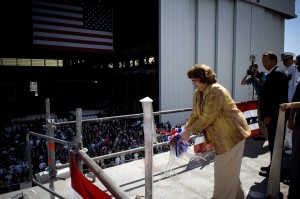 Navy Times‘ Phil Ewing (who now works for Politico) gleefully treated the LCS-2 Christening to a full-on hit piece, with a story “LCS-2: Unusual Ship, Unusual Christening“. The snark was wonderful…Here’s a snippet:
Navy Times‘ Phil Ewing (who now works for Politico) gleefully treated the LCS-2 Christening to a full-on hit piece, with a story “LCS-2: Unusual Ship, Unusual Christening“. The snark was wonderful…Here’s a snippet:
“This particular ceremony would be the equivalent of the minister or priest dunking the baby’s tummy in the christening font, or sprinkling the water there instead of on its head,” said naval expert A.D. Baker III, a former analyst in the Office of Naval Intelligence and editor of “Combat Fleets of the World.”
Baker, who helped oversee ship christenings when he worked for Navy Secretary John Lehman, said he never saw a champagne bottle broken on a ship in a position comparable to the one on Independence.
Amazing, no? After that…there was much NAVSEA clucking and hand-wringing–and, by all reports, outright fury in the higher ranks–and since then, by God, all subsequent Independence Class Christenings have been on the bow, taxpayers be damned.
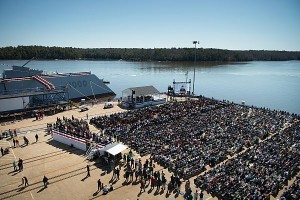 Now, let’s turn to the DDG-1000, the mighty Zumwalt, which was Christened this weekend. Due to the innovative tumblehome hull-form, Bath Ironworks followed the LCS-2 example….the bottle was broken well aft, just in front of the big, boxy main gun (Look closely and you’ll notice the little “Z” in front of the gun).
Now, let’s turn to the DDG-1000, the mighty Zumwalt, which was Christened this weekend. Due to the innovative tumblehome hull-form, Bath Ironworks followed the LCS-2 example….the bottle was broken well aft, just in front of the big, boxy main gun (Look closely and you’ll notice the little “Z” in front of the gun).
But, like any good, well-behaved guests, nobody commented on the breach of naval tradition. Navy Times merely noted the bottle was smashed “near” the bow, and moved on, using the occasion to shill for the vessel, writing a glowing story that included these little bon mots:
Among the 15,000-ton warship’s cutting-edge features are a composite deckhouse with hidden radar and sensors and an angular shape that officials say will allow it to be confused for a small fishing boat on radars. It also sports wave-piercing hull designed to reduce the ship’s wake. It’s the first U.S. ship to use electric propulsion and produces enough power to one day support the futuristic electromagnetic rail gun, which will be tested at sea in 2016.
Inside, sailors will have more space to work and live because the Zumwalt will only require about half the crew of the current generation of destroyers. Meanwhile, fewer sailors will need to stand watch because of cameras and video monitors that show what’s going on outside.
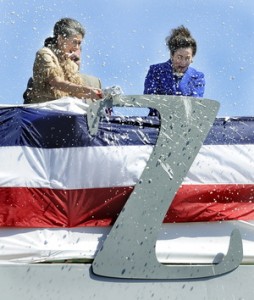 So…aside from the gentle passover of the christening location, notice how up has become down? The very qualities that are, right now, sinking the LCS are spun as DDG-1000 positives.
So…aside from the gentle passover of the christening location, notice how up has become down? The very qualities that are, right now, sinking the LCS are spun as DDG-1000 positives.
Let’s dig a little deeper:
Manning: DDG-1000 Sailors get more space because a crew that is, oh, barely twice the size of the LCS crew are being asked to operate a ship with a 5-times larger displacement? And a far more complex battle-management task?
How is that going to work, exactly? When, pray tell, will they sleep?
Bridge Wings/Visibility: Notice, in the piece above, how naturally the author accepts the ship must rely on cameras to sail, since it–in part–doesn’t have bridge wings (To the DDG-1000’s credit, I really like the bridge layout and how the camera feeds will be integrated into it). To compare, sailors were so upset over LCS not having bridge wings (one LCS sailor told me, “I trust a Mark 1 eyeball over a !@$%ing camera”), they’ve back-fitted bridge wings on LCS-2–big Gucci ones too, with Big Eyes, an ashtray and more (see the photo below).
Radar signature be dammed, small-ship sailors have gotta have their bridge wings so they can survive, what? Mooring? And, yes, the lack of bridge wings got the LCS-disparaging Navy Times Treatment, too, in 2010:
Engineers and designers may like the sleek profile and low radar signature of a superstructure without bridge wings, but the design drives surface warfare-types crazy, said a retired cruiser commander who asked not to be identified because of an ongoing relationship with the Navy.
On paper, cameras and sensors seem like they’ll give the same information as human eyes and ears, but in practice, that seldom proves true especially when sensors replace a human.
“If someone falls over the side, how are you going to see them?” the former cruiser skipper asked, worrying that a sailor could be lost at sea if he went overboard in a blind spot between topside cameras.
And if mooring Independence is tricky with no bridge wings and only roll-down windows, mooring a Zumwalt-class destroyer could be even harder: All of its bridge windows are designed to stay sealed, to maintain the positive pressure inside the ship, the cruiser skipper said.
But that won’t last long, he said, because captains won’t stand for it.
`They’re going to say, `You mean, every time I come into port I’ve got to just sit there and be pushed onto the dock by tugs, and I’ve got no say in that? No way I’m going to disable the positive pressure and open the windows so I can see out.’
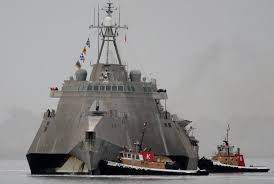 Survivability and Hull Material: Oh, and then there’s the DDG-1000’s exquisitely expensive composite, balsa-wood core deckhouse. How durable and survivable will that actually be? I mean, for all the yelling about aluminum in fires and LCS survivability (I won’t link, just do a search), I simply can’t wait to see how composite holds up to a good rocket-fuel fire. I hear the fumes are a killer. And balsa? In seawater? Yikes. (If interested, here’s a discussion on how hard it was to fight the composite-fueled B-2 fire–note the amount of water they needed to put it out–but it is also worth noting that the aircraft–in an epic engineering feat–has been totally repaired and is back in service)
Survivability and Hull Material: Oh, and then there’s the DDG-1000’s exquisitely expensive composite, balsa-wood core deckhouse. How durable and survivable will that actually be? I mean, for all the yelling about aluminum in fires and LCS survivability (I won’t link, just do a search), I simply can’t wait to see how composite holds up to a good rocket-fuel fire. I hear the fumes are a killer. And balsa? In seawater? Yikes. (If interested, here’s a discussion on how hard it was to fight the composite-fueled B-2 fire–note the amount of water they needed to put it out–but it is also worth noting that the aircraft–in an epic engineering feat–has been totally repaired and is back in service)
But survivability aside, let’s put it this way–imagine if the LCS had a deckhouse that, for some reason, was found to be unsuitable, and was replaced with a steel model–which, in turn, required the shutdown of an entire yard…It happened with DDG-1003. If that happened to LCS, why, there’d be a huge amount of screaming and no more LCS. Clear and simple. The program would be done.
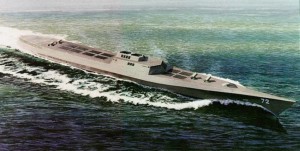 Price: Senator John McCain, in his regular “get off my lawn” treatment of the LCS, is quick to remind everyone that the first, off-the-cuff estimate of the LCS cost was $250 Million. Who recalls that the original estimate of the arsenal ship was $450 million as a fixed, sailaway cost? But that’s been lost as the program re-jiggered and re-baselined itself into a $3-billion dollar colossus. By the time DDG-1002 is Christened, Bath will be crowing to Congress about how successful it has been in (cough) controlling cost.
Price: Senator John McCain, in his regular “get off my lawn” treatment of the LCS, is quick to remind everyone that the first, off-the-cuff estimate of the LCS cost was $250 Million. Who recalls that the original estimate of the arsenal ship was $450 million as a fixed, sailaway cost? But that’s been lost as the program re-jiggered and re-baselined itself into a $3-billion dollar colossus. By the time DDG-1002 is Christened, Bath will be crowing to Congress about how successful it has been in (cough) controlling cost.
To conclude, the DDG-1000 program is getting pass after pass after pass. I don’t know why–perhaps this is the consequence of having a program big enough to keep everybody happy–mixing old tech and new, spreading the wealth between several different big contractors. And, also, let’s not discount that the DDG-1000 has had an epic birthing process that spans from, oh, the Cold War-era, battleship-replacement arsenal ship of old.
To the DDG-1000’s credit, the program has gone through the PR grist-mill. I mean, as a program, it was canceled so many times, the basic concept became something of an infamous joke, one of those zombie ideas that just wouldn’t die. If the Marines weren’t screaming for a Zumwalt-esque ship as a fire-support platform, the missile defense folks were yelling for it. It became the ship of dreams, with a little bit for everybody, transformers and old-school alike (while the LCS–like any small warship–became an exercise in compromise).
The sense of relief that this program is underway is both generational and palpable.
But many of the problems we have already identified with the LCS will also impact the DDG-1000. And it is high time we started thinking about them. We better, because, if I know the new General Dynamics chief shipbuilding honcho, we’ll be building a heck of a lot more of ’em (oh, and you think we’re only building three? Riiiight). But at $3 Billion a pop, the Navy and our sailors might benefit if the press gave DDG-1000 a little more than “shock, awe and fawning” media scrutiny.

{ 14 comments… read them below or add one }
As noted by the previous poster the Mark 1 human eyeball is pretty hard to replace with cameras. So totally agree that replacing human watch-standers with cameras is really bad idea as he overall situational awareness of the traditional watchstander is hard to beat.
Further, the small size of the crew will ensure it will not be able to survive and recover from the kind of serious damage that a WWII cruiser could handle.
Also, what about force protection? The LCS crew is so small that many ports that
a real warship can visit are off-limits to the LCS. In many cases force protection has to be flown in for it. At $3 billions dollar plus per ship, the 148 person crew of the Zumwalt is quite a bit larger than that of LCS, but for a ship of it size and value it is still very small and it does make it a tempting target for close assault operations.
However we can be comforted that its Total Ship Computing architecture (Powered by Linux!) makes up for all its shortcomings.
Many good points. Fundamentally video monitors are not as good as human eyes. They present 2D images of a 3D environment with a focal-point designed to compromise between up-close imagery and the horizon. The human eye has a full range of focal length and can adjust in microseconds — once it notices something out of focus in the distance.
Cameras also have a limited field of view. Yes, we can put a bunch in a circle and say we have 360° coverage — and we do — horizontally only. The human observer is able to stare at the horizon and yet see almost 90° upward and 90° downward and make out events requiring attention. Nobody’s yet come up with a 360° horizontal by 180° monitor bank. Even an Imax display is 30° of vertical space.
Why do we care? Man overboard is looking straight down. Zodiac with IEDs is looking right at the surface of the ocean to catch an insignificant out-of-focus craft barely sticking out of the water. An IED “drone” (UAS) from shore is looking not only upward but *listening* for the hum of the props.
Computers can do all these things, but not as well as humans. Still if it’s great for the Zumwalt it’s great for the LCSs… except it isn’t great for either.
Craig, can you make a credible case that Zumwalt wont stop after three hulls? I am not aware of any such discussions or orders for long lead items etc. If this were to happen, it would have to happen right now.
Otherwise your – sorry – somewhat polemic rant goes out of the window right here. DDG-1000 is not an operational design for fleet use. Its a cancelled program that is right now producing some prototypes for extended testing. They may or may not be used in operations to some degree, it matters little. Your crititcism re price is exactly what has caused cancellation. To a lesser degree so have some of the other points.
DDG-1000 doesnt get passes. It has failed already. LCS is a failure in progress.
Craig; you bounced around a ton of topics – a couple of gentle observations
– Cancellation is a panacea for criticism – of course Zumwalt gets a pass
– Arsenal is the key term; why is the SWO community wasting multiple surface combatants tethered to a geographic axis providing VLS inventory? Seriously; the BMD role in EPAA could be played as a ‘suped up’ Desert Ship shooter remote and some VLS cans on a deck (barge or general Cargo). Hell; if on a barge the ‘Aegis Ashore’ could be dragged up any number of navigable rivers…
– While the sex appeal of Buck Rogers rayguns and rail guns reaches back to the comic books of youth; the laser looks exceedingly unlikely (physics hates directed energy) and the rail guns need at least a decade of guided projectile R&D. A bog-standard naval artillery gun (or with rocket assist) and terminal guidance looks to be a valuable warfighting tool for another 3-5 decades at least.
– LCS as a ‘network of sensing and weapons’ misses the mark; if the coin of the realm is coverage and speed – consider revisiting the employment of the MQ-4 to support the fleet and make effective use of those naval air stations.
Yeah I was bewildered myself, but as near as I could tell he was dead serious.
Could it be done? Hell sure but I sure as heck wouldn’t want to pay for it.
Good to hear from you Moose….but I gotta say that your last sentence scares the bejezus out of me. A 5000 Ton, 45 Kt Aegis Frigate?
I suppose it could be done if it was made of aluminum and had multiple hulls, no?
We need a good presence patrol ship that isn’t all things to all people. The Floreal, for god’s sakes, does fine. Or an Endurance-like ship. Simple, easy, non-goldplated!!!
I don’t think OPC will be an LCS killer so much as an LCS-B option if the type gets split in two directions: module mothership and affordable “presence” patrol ship. Neither of those is likely to be called a “frigate” so expect the mouth-foaming from some quarters to continue, but boy would it make things easier on the Coasties having the Navy driving OPC unit costs down with a big order.
The potential return of the speed requirement concerns me. JHSV needs speed (and to loose the “J”) but that’s about it. I had thought it was becoming popular orthodoxy that the speed requirement should be dropped in favor of space/affordability, but then I had a chat with a recently retired SWO who swore up and down what the Navy “needs” is a 5000t, 45-knot Aegis Frigate……
I suspect that the primary reason the DDG-1000s get a “free pass” is because it’s already been cancelled, as soon as the LCS program gets the axe it will be a PR bonanza as everyone and their brother suddenly find the LCS to have been genious and it’s replacement to be a huge mistake.
Bob– Six? Yes, breaking up some “in production” LCS on the ways might be enough to silence critics, but…that’s doubtful.
Writing the DDG-1000 off as some sort of repeat of the Norfolk Class is a mistake. I think we’ll see another block of them get produced, at least.
The DDG 1000 program didn’t exactly get pass after pass after pass. It got cut to three vessels, which are now seen as having some value as experimental platforms. Cut the LCS program to, say, six vessels and the critics will be silenced.
Paul–
Great comment. I think General Dynamics is chuckling at the idea that they’re only gonna build three DDG-1000s. And I think the decision to build more will happen pretty darn quick. But that’s just little ‘ole me.
I would love to see experimental fleets out there. Bob Work’s original vision was for two fleets of ten or so to be out there operating before downselecting. I mean, if he thought that was worth doing for platform/tactical development alone (nevermind the benefits that would come from getting O-5 and O-4 seatime and flotilla command experience), then Iet’s make it happen. But I think people would blanche at the costs (as they are doing now.)
Now….Iet me throw this out there…Could OPC be the LCS-killer? Thoughts?
Craig,
Why does DDG-1000 get a pass?
While you maybe right that we will come back to it as a future design, we are currently building 3 *and only 3*, and giving them to the Fleet to “get used to” (and hopefully experiment around with…). The prototype horses are going before the production line carts. Any future CG class that derives from it will probably have at least a decade of operations of these first 3 prototypes on the books to “get it right”.
With LCS we are building an entire class (at least 32 if not more) based on BOGSAT-level employment concepts that keep changing and a HOPE that it will be useful for something that justifies its cost compared to something like a JHSV. I think the combination of a “ready, fire, aim” mentatlity to buying the ships “just to get hulls in the water” and the continued failure to get the piece-parts of the mission modules working comes off as at least amateurish, if not waste, fraud and abuse…
If on the other hand, we built say a squadron of 8 (4 of each), organized them into 2 flotillas, and put a deep-thinking O-5 in charge and hard-charging O-4s in command. Then dusted off the ideas behind how we did the “Fleet problems” between the wars and told them to pretend it was 2020. Then gave them a budget to support those experiments with whatever surrogates for what they would want beyond 2020 (sort of how SOCOM does things, but at a MUCH smaller scale…) and actually FIGHT EACH OTHER (electronically of course…). And then take say 3-5 years worth of that process and fold it into the next 8 production models (sending them to the fleet). Wash Rinse and Repeat, say with a flight of 12-16 the next time…
Now THAT would have been a truely ‘innovative’ process that would motivate HUGE interest in showcasing how creative our young shipmates can be when they are giving a challenge – a live action video game to win! Crumudgeons like me would be too busy monday-morning quarterbacking “the game” to critique the foibles and limitations of the individual platforms – they are SURROGATES after all for what will come next, and when those come, the debates about them will have actual experience to back them up, not just heckling from the balcony.
DDG-1000 may be just as far from “soup yet” as LCS, but at least the FLEET is going to see what she can do, before “going all in” on her design. People are more willing to give that “a pass” than LCS – where there is this huge vacuum left in the wake of how fast it is getting fire-hosed to the Fleet! A vacuum that, without a coherent strategy to ease the turbulance, leaves the crumudeons to fill it faster than the advocates, whose arguments are only powerpoint deep at this stage.
Lots of good stuff here, and thanks for commenting.
Yeah, there’s no excuse for the overselling and gold-plating that went into LCS’s capability mix. The mission modules are a mess, and had they gone the route of, say, the JHSV, focusing on the basic, simple, organic features first, and mastering them (i.e. For the LCS-2 that’s the gun, helo, open Architecture computing environment, SAAB radar, and launch-recovery systems) I’d wager that the reception would be a bit better.
At least the tenor of the PR would be about discovering the neat new capabilities (ASW/MIW/etc) the ship can support versus being angry that the ship doesn’t have the capabilities that were originally advertised.
I agree with you on the innovative hullforms. I’m glad to see some experimentation going on. It’s been hard–the performance aspects of monohulls and screw propulsion has been so baked into the system, I worry that things like tests and trials try to force these new hullforms into a conventional straitjacket. They’re not looking at what the new hulls can do, but wondering more about why these hulls don’t act like a conventional one. And that’s bad, particularly when you get to tactics and conops.
Take heavy weather. In a wave-piercing trimaran, the last thing you want to do is to slow down in higher seas. A small ship that can move darn fast in a high sea state is worth appreciating.
I think the bridge wing issue…lots of issues…inexperienced skippers unfamiliar with the task or the ship, a greater appreciation of the small boat launch/recovery capability (and an exquisite awareness of the penalties of loosing somebody during it, the immature state of the tech and it’s user interface…It’s hard to balance that against things like, oh, discipline required to operate, say, in a radiologically contaminated environment.
And with the state of systems engineering these days, I’m sure somebody was patting themselves on the back for, oh, testing the radar cross-section of the new bridgewings, while, at the same time, failing to consider the performance impact of installing something nice and heavy up in the superstructure when, in fact, something far more simple would suffice. (LCS-2 has margin, but, like any high-speed vessel, you need to follow some rules about how you add it…)
Going back to the DDG-1000, it’s a great mix of old and new. VLS cells are going to work. A big gun is gonna work. To some extent, they took off-the-shelf capability and layered in the higher tech potential. And where some of that tech didn’t work, they had the margin and space to make easy fixes–on a ship of 16,000 tons, that’s a relatively easy thing! Again, the task is far harder on a smaller ship. (But it would be nice if somebody decided that some of the concepts out there on LCS don’t work–like, say, minimal manning–that they got proactive, and fixed the issue, rather than paying folks once to build a flawed ship, and then a second time to fix the flaw.)
I do disagree with you about the lineage. DDG-1000 is a platform that grew out of the final days of the Cold War…and luckily for the platform, it seems we’re teetering on the brink of one again! I think we’ll be building more than three of these…
Craig,
Perhaps DDG-1000 is getting more credibility because it is a warship with weapons that can shoot over-the-horizon, out of the yard, not at an undetermined point in the future when a mission module is finally available that works.
As far as the non-standard hull designs, personally, I think the trimaran is a great idea. One that I would like to see applied to a destroyer or a real frigate. Its hydrodynamic efficiency and ability to maintain speed in higher sea states without beating the hull up are great advantages.
Perhaps a generation comfortable with back up cameras and self-parking cars will be more comfortable without bridge wings in the future. Hopefully, the Navy performed some analysis to show that the bridge wings impact on radar signature was minimal before making the change.
I think you are crossing program streams to claim DDG-1000 is the descendant of the Arsenal Ship Program. Arsenal Ship and SC-21 were separate programs and different concepts. According to the CRS, “The program was originally designated DD-21, which meant destroyer for the 21st Century. In November 2001, the program was restructured and renamed DD(X), meaning a destroyer whose design was in development. In April 2006, the program’s name was changed again, to DDG-1000, meaning a guided missile destroyer with the hull number 1000.” Both ship concepts emphasized land attack, but the Arsenal Ship was envisioned as large missile carrier, up to 500 missiles, largely reliant on a cooperative engagement capability (CEC) rather than its own onboard sensors and fire control. An extended missile magazine for other combatants. In my opinion, the Arsenal Ship was and remains an idea worth pursuing in a fully realized form apart from the SSGNs, particularly in the missile defense mission set.
In the main, I think that most observers have little doubt the Zumwalt can be an adequate destroyer, but a lot of people doubt the LCS can be a good frigate replacement or mine hunter or submarine hunter. I hope you are correct that more Zumwalts or Zumwalt derived ships get built because I have my doubts about the Flight III Burkes given the degree of redesign involved and how densely packed the ships are going to be.